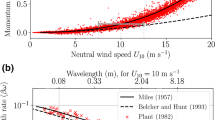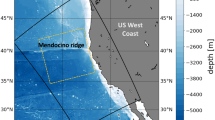Abstract
In the ocean, wind-generated kinetic energy (KE) manifests itself primarily in balanced currents and near-inertial waves. The dynamics of these flows is strongly constrained by the Earth’s rotation, causing the KE in balanced currents to follow an inverse cascade but also preventing wave-wave interactions from fluxing energy in the near-inertial band to lower frequencies and higher vertical wavenumbers. How wind-generated KE is transferred to small-scale turbulence and dissipated is thus a non-trivial problem. This article presents a review of recent theoretical calculations and numerical simulations that demonstrate how some surprising modifications to internal wave physics by the lateral density gradients present at ocean fronts allow for strong interactions between balanced currents and near-inertial waves that ultimately result in energy loss for both types of motion.


















Similar content being viewed by others
Notes
This expression for f e f f is only valid for straight fronts. If the front is curved, inertial motions oscillate at a frequency that depends on the flow curvature as well, see for example Kunze and Boss (1998).
Note that since the front is two-dimensional, there is no geostrophic flow nor thermal wind shear in the y-direction.
This is true for a front with upward sloping isopycnals where v ′ and w ′ are positively correlated as shown in Fig. 3, and as used in the stability analysis plotted in Fig. 4. When isopycnals slope downward, the times of maximum inertial shear and maximum |v ′| must coincide for PSI to develop since v ′ and w ′ are anti-correlated in that case.
Note that for this simple frontal zone without vertical vorticity, the slope of M −surfaces is s M = f 2/S 2 = R i g s ρ . Hence as R i g → 1, s M approaches the isopycnal slope s ρ .
References
Alford M (2003) Redistribution of energy available for ocean mixing by long-range propagation of internal waves. Nature 423:159–163
Alford M, Gregg M (2001) Near-inertial mixing: modulation of shear,strain and microstructure at low latitude. J Geophys Res 106:16,947–16,968
Alford M, Shcherbina AY, Gregg MC (2013) Observations of near-inertial internal gravity waves radiating from a frontal jet. J Phys Oceanogr 43:1225–1239
Balmforth NJ, Young WR (1999) Radiative damping of near-inertial oscillations in the mixed layer. J Mar Res 57:561–584
Barkan R, Winters KB, McWilliams JC (2017) Stimulated imbalance and the enhancement of eddy kinetic energy dissipation by internal waves. J Phys Oceanogr 47:181–198
Eliassen A (1962) On the vertical circulation in frontal zones. Geofys Publ 24:147–160
Elipot S, Lumpkin R, Prieto G (2010) Modification of inertial oscillations by the mesoscale eddy field. J Geophys Res 115:C09,010
Ferrari R, Wunsch C (2009) Ocean circulation kinetic energy: reservoirs, sources, and sinks. Annu Rev Fluid Mech 41:253–282
Ferrari R, Wunsch C (2010) The distribution of eddy kinetic and potential energies in the global ocean. Tellus A 62:92–108
Grisouard N, Thomas LN (2015) Critical and near-critical reflections of near-inertial waves off the sea surface at ocean fronts. J Fluid Mech 765:273–302
Grisouard N, Thomas LN (2016) Energy exchanges between density fronts and near-inertial waves reflecting off the ocean surface. J Phys Oceanogr 46:501–516
Healey D, LeBlond PH (1969) Internal wave propagation normal to a geostrophic current. J Mar Res 27:85–98
Holton JR (2004) An introduction to dynamic meteorology, 4th edn. International Geophysics Series, Elsevier Academic Press, Burlington, MA
Inoue R, Gregg MC, Harcourt RR (2010) Mixing rates across the Gulf Stream, part 1: on the formation of eighteen degree water. J Mar Res 68:643–671
Ivey GN, Nokes RL (1989) Vertical mixing due to the breaking of critical internal waves on sloping boundaries. J Fluid Mech 204:479–500
Joyce T, Toole J, Klein P, Thomas L (2013) A near-inertial mode observed within a Gulf Stream warm core ring. J Geophys Res 118:1–10. doi:10.1002/jgrc.20141
Kunze E (1985) Near-inertial wave propagation in geostrophic shear. J Phys Oceanogr 15:544–565
Kunze E (1986) The mean and near-inertial velocity fields in a warm-core ring. J Phys Oceanogr 16:1444–1461
Kunze E, Boss E (1998) A model for vortex-trapped internal waves. J Phys Oceanogr 28:2104–2115
Kunze E, Sanford T (1984) Observations of near-inertial waves in a front. J Phys Oceanogr 14:566–581
Kunze E, Schmidt RW, Toole JM (1995) The energy balance in a warm-core ring’s near-inertial critical layer. J Phys Oceanogr 25:942–957
McComas CH, Bretherton FP (1977) Resonant interaction of oceanic internal waves. J Geophys Res 82:1397–1412
Mooers CNK (1975) Several effects of a baroclinic current on the cross-stream propagation of inertial-internal waves. Geophys Fluid Dyn 6:245–275
Müller P, Holloway G, Henyey F, Pomphrey N (1986) Nonlinear interactions among internal gravity waves. Rev Geophys 24:493– 536
Nagai T, Tandon A, Kunze E, Mahadevan A (2015) Spontaneous generation of near-inertial waves by the Kuroshio front. J Phys Oceanogr 45:2381–2406
Olbers DJ (1981) The propagation of internal waves in a geostrophic current. J Phys Oceanogr 11:1224–1233
Plueddemann AJ, Farrar JT (2006) Observations and models of the energy flux from the wind to mixed-layer inertial currents. Deep-Sea Res II 53:5–30
Polzin KL (2010) Mesoscale eddy-internal wave coupling. Part II: energetics and results from PolyMode. J Phys Oceanogr 40:789–801
Polzin KL, Lvov YV (2011) Toward regional characterizations of the oceanic internal wavefield. Rev Geophys 49:rG4003. doi:10.1029/2010RG000329
Rainville L, Pinkel R (2004) Observations of energetic high-wavenumber internal waves in the Kuroshio. J Phys Oceanogr 34:1495–1505
Sawyer JS (1956) The vertical circulation at meterological fronts and its relation to frontogenesis. Proc R Soc Lond A 234:346–362
Shakespeare C, Taylor J (2014) The spontaneous generation of inertia–gravity waves during frontogenesis forced by large strain: theory. J Fluid Mech 757:817–853
Shakespeare CJ, Hogg A (2017) Spontaneous surface generation and interior amplification of internal waves in a regional-scale ocean model. J Phys Oceanogr 47:811–826
Shakespeare CJ, Taylor JR (2013) A generalized mathematical model of geostrophic adjustment and frontogenesis: uniform potential vorticity. J Fluid Mech 736:366–413. doi:10.1017/jfm.2013.526
Shcherbina AY, Talley LD, Firing E, Hacker P (2003) Near-surface frontal zone trapping and deep upward propagation of internal wave energy in the Japan East Sea. J Phys Oceanogr 33:900–912
Taylor S, Straub D (2016) Forced near-inertial motion and dissipation of low-frequency kinetic energy in a wind-driven channel flow. J Phys Oceanogr 46:79–93
Thomas LN (2012) On the effects of frontogenetic strain on symmetric instability and inertia-gravity waves. J Fluid Mech 620–640
Thomas LN (2017) Near-inertial waves in fronts undergoing frontogenesis. J Phys Oceanogr in preparation
Thomas LN, Taylor JR (2014) Damping of inertial motions by parametric subharmonic instability in baroclinic currents. J Fluid Mech 743:280–294
van Meurs P (1998) Interactions between near-inertial mixed layer currents and the mesoscale: the importance of spatial variabilities in the vorticity field. J Phys Oceanogr 28:1363–1388
Vanneste J (2013) Balance and spontaneous wave generation in geophysical flows. Ann Rev Fluid Mech 45:147–172
Wagner G, Young W (2016) A three-component model for the coupled evolution of near-inertial waves, quasi-geostrophic flow and the near-inertial second harmonic. J Fluid Mech 802:806–837
Whitt DB, Thomas LN (2013) Near-inertial waves in strongly baroclinic currents. J Phys Oceanogr 43:706–725
Whitt DB, Thomas LN, Klymak JM, Lee CM, D’Asaro EA (2017) Trapped super-inertial waves in the Gulf Stream. J Phys Oceanogr Submitted
Xie JH, Vanneste J (2015) A generalised-Lagrangian-mean model of the interactions between near-inertial waves and mean flow. J Fluid Mech 774:143–169
Young WR, Ben-Jelloul M (1997) Propagation of near-inertial oscillations through a geostrophic flow. J Mar Res 55:735–766
Zeitlin V, Reznik GM, Ben Jelloul M (2003) Nonlinear theory of geostrophic adjustment. Part 2. Two layer and continuously stratified primitive equations. J Fluid Mech 491:207–228
Acknowledgements
This article reviews material that I was invited to present at the 48th Liege Colloquium on Submesoscale Processes: Mechanisms, Implications and New Frontiers. I would like to thank Alexander Barth, Eric Deleesnijder, Amala Mahadevan, Ananda Pascual, Simon Ruiz, and Charles Troupin for organizing such a stimulating meeting and inviting me to speak. This work was funded by the National Science Foundation grant OCE-1260312.
Author information
Authors and Affiliations
Corresponding author
Additional information
Responsible Editor: Amala Mahadevan
This article is part of the Topical Collection on the 48th International Liège Colloquium on Ocean Dynamics, Liège, Belgium, 23–27 May 2016
Rights and permissions
About this article
Cite this article
Thomas, L. On the modifications of near-inertial waves at fronts: implications for energy transfer across scales. Ocean Dynamics 67, 1335–1350 (2017). https://doi.org/10.1007/s10236-017-1088-6
Received:
Accepted:
Published:
Issue Date:
DOI: https://doi.org/10.1007/s10236-017-1088-6




